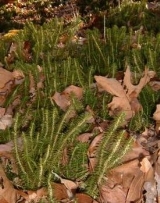
Huperziaceae
Encyclopedia
The family Huperziaceae is one of two families sometimes recognized in the order Lycopodiales
, and contains two or three extant genera:
The genera of Huperziaceae are included in the family Lycopodiaceae
in several classifications (in fact older classifications included the species of Huperzia within Lycopodium) and there is as yet no consensus as to whether Huperziaceae should be recognized as a distinct family. The plants are distinct from those of Lycopodiaceae s.s. in having erect (not creeping) growth; and in its spore
-bearing structures being produced in the axils of unmodified leaves
, unlike the terminal club-like structure produced by species in the Lycopodiaceae. The family also has a basal chromosome count of n=67, versus counts of n=23, 34 in the Lycopodiaceae.
Lycopodiopsida
Lycopodiopsida is a class of plants often loosely grouped as the fern allies. Traditionally the group included not only the clubmosses and firmosses, but also the spikemosses and the quillworts...
, and contains two or three extant genera:
- Huperzia (temperate firmosses); 10-15 species; terrestrial.
- Phlegmariurus (tropical firmosses); about 300-400 species; often included in Huperzia; mainly epiphyteEpiphyteAn epiphyte is a plant that grows upon another plant non-parasitically or sometimes upon some other object , derives its moisture and nutrients from the air and rain and sometimes from debris accumulating around it, and is found in the temperate zone and in the...
s. - PhylloglossumPhylloglossumPhylloglossum, a genus in the clubmoss family Huperziaceae, is a small plant superficially resembling a tiny grass plant, growing with a rosette of slender leaves 2-5 cm long from an underground bulb-like root...
(Pygmy Clubmoss); formerly thought to be only distantly related to Huperzia. This is a terrestrial, grass-like plant with basal, 2-5 cm long, fleshy leavesLeafA leaf is an organ of a vascular plant, as defined in botanical terms, and in particular in plant morphology. Foliage is a mass noun that refers to leaves as a feature of plants....
. The only listed species is Phylloglossum drummondii.
The genera of Huperziaceae are included in the family Lycopodiaceae
Lycopodiaceae
The Lycopodiaceae is a family of primitive vascular plants, including all of the core clubmosses. These plants bear spores on specialized structures at the apex of a shoot; they resemble a tiny battle club, from which the common name derives...
in several classifications (in fact older classifications included the species of Huperzia within Lycopodium) and there is as yet no consensus as to whether Huperziaceae should be recognized as a distinct family. The plants are distinct from those of Lycopodiaceae s.s. in having erect (not creeping) growth; and in its spore
Spore
In biology, a spore is a reproductive structure that is adapted for dispersal and surviving for extended periods of time in unfavorable conditions. Spores form part of the life cycles of many bacteria, plants, algae, fungi and some protozoa. According to scientist Dr...
-bearing structures being produced in the axils of unmodified leaves
Leaf
A leaf is an organ of a vascular plant, as defined in botanical terms, and in particular in plant morphology. Foliage is a mass noun that refers to leaves as a feature of plants....
, unlike the terminal club-like structure produced by species in the Lycopodiaceae. The family also has a basal chromosome count of n=67, versus counts of n=23, 34 in the Lycopodiaceae.

